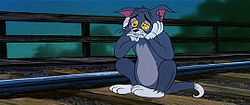Blue Cat Blues
| Blue Cat Blues | |
|---|---|
| Tom and Jerry series | |
 Title Card | |
| Directed by |
William Hanna Joseph Barbera |
| Produced by |
William Hanna Joseph Barbera |
| Story by |
William Hanna Joseph Barbera |
| Voices by | Paul Frees (Uncredited) |
| Music by | Scott Bradley |
| Animation by |
Ed Barge Irven Spence Lewis Marshall Kenneth Muse |
| Layouts by | Richard Bickenbach |
| Backgrounds by | Robert Gentle |
| Distributed by | Metro-Goldwyn-Mayer |
| Release date(s) | November 6, 1956 (US) |
| Color process |
Technicolor CinemaScope |
| Running time | 6:50 |
| Language | English |
| Preceded by | Down Beat Bear |
| Followed by | Barbecue Brawl |
Blue Cat Blues is the 103rd one reel animated Tom and Jerry short, created in 1955, directed and produced by William Hanna and Joseph Barbera with music by Scott Bradley. The cartoon was animated by Ed Barge, Irven Spence, Lewis Marshall and Kenneth Muse, with layouts by Richard Bickenbach and backgrounds by Robert Gentle.
Unusual for a Tom and Jerry short, Jerry "speaks", narrating the story in voiceover via Paul Frees. Since Jerry narrates through inner monologue, the short does not break the "cardinal rule" of not having Tom or Jerry physically speaking on screen. Also, unusually for a Tom and Jerry cartoon, while all the others have comical storylines, this one has a tragic storyline. Because of this—and the implied suicide at the end—this cartoon has rarely been seen on American TV. It has aired once on TNT in the early 1990s and made its rounds on local affiliate channels, but hasn't aired on TBS, Cartoon Network, or Boomerang. However, the short aired for only once on Cartoon Network Southeast Asia on November 2010. As of January 2014, very few airings are known but it has been shown briefly on Cartoon Network in the USA.
This cartoon was released on November 16, 1956 by Metro-Goldwyn-Mayer.
Plot

Jerry relates the events leading up to Tom's depression: Tom and Jerry had been inseparable best friends, until Tom became attracted to a female cat. The female feline initially reciprocates Tom's feelings, but Tom's rival, the much wealthier Butch, is suddenly smitten by her as well, rudely interrupting her date with Tom to make his move. The female cat shows herself to be an opportunist and, attracted by Butch's wealth, immediately leaves Tom for him.
Tom pushes himself and his finances to the limit trying to win his girlfriend back with presents such as flowers, perfume, diamond rings, and a car, but the gold-digging, black-hearted cat rejects all of his efforts, as Butch's presents are much bigger, more expensive, and much more outrageously extravagant (including a tanker truck full of perfume and a ring with a diamond so large and shiny that it cannot be looked at without eye protection).
Now broken-hearted, penniless, and deep in debt, Tom tries to drown his sorrows in milk, deaf to Jerry's pleas to stop. Tom is about to literally let himself go down the gutter until Jerry, at the last second, rescues him. Just when Tom's life could not get any worse, he sees that his ex-girlfriend is now Butch's wife; the pair drive past him in a car laden with luggage, with a "Just Married" sign on the back.
Jerry breaks from the sad story to think about his own girlfriend, "Toots," happy that, unlike how Tom's ex-girlfriend was to him, she has been faithful to Jerry. Suddenly, Jerry's idyllic world is shattered when Toots rides by with another mouse, a "Just Married" sign on the back of their car. The now-dejected Jerry then joins Tom on the railroad tracks. They wait for an incoming train which draws near. The sound of the whistle of the incoming train turns louder as the cartoon comes to a close.